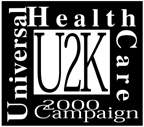Intro | Private Ins. | Medicare | Medicaid | Managed Care | Crisis | Reform

|
Managed Care |
History
In the 1940s and 50s, several pioneering "prepaid group practices" were developed. These groups collected a single charge for all care to an entire group of patients, rather than individual fees for individual services. In the early 1970s, President Nixon encouraged the expansion of this type of practice organization, renamed Health Maintenance Organizations, as an alternative to national health insurance plans then being promoted by Democrats.
HMO enrollment grew slowly until the late 1980s when large corporations began forcing employees into them. Subsequently, these same forces convinced governments to encourage or require them for recipients of public insurance, Medicaid and Medicare.
HMO's restrict choice of physicians and hospitals to those in their plan. Resistance to this feature led the insurance industry to create new insurance products that allow some wider choice. The two broad types are PPO‚s (Preferred Provider Organizations) and POS (Point of Service plans). PPO‚s enlist a panel of health providers; a patient may choose a non-panel provider, though the co-pays will be more. A POS plan allows patients to see anyone who will accept the plan's reimbursement rate. The initial prepaid plans, such as Kaiser and Group Health Associations were nonprofit. In recent years, for-profit insurance company chains have become dominant.
Current Status
Employer-sponsored health insurance, medium and large firms, by plan type:
| 1988 | 1992 | 1996 | 1998 | |
| Conventional | 71% | 45% | 26% | 14% |
| HMOs | 18% | 22% | 33% | 30% |
| PPOs | 11% | 26% | 25% | 34% |
| POS | 0 | 8% | 16% | 22% |
Percentage of publicly insured patients enrolled in managed care:
| Medicaid | Medicare | |
| 1989 | 9% | 5% |
| 1991 | 10% | 6% |
| 1993 | 14% | 7% |
| 1995 | 29% | 10% |
| 1997 | 48% | 14% |
Distribution of HMO enrollment by ownership status:
| Nonprofit | For profit | |
| 1981 | 88% | 12% |
| 1985 | 74% | 26% |
| 1989 | 54% | 46% |
| 1993 | 48% | 52% |
| 1997 | 37% | 63% |
Range of Managed Care Penetration in States, 1996:
(Managed Care = HMO + PPO + POS)
High (more than 80%): Arizona (89%), California (93%), Colorado (82%), DC (91%), Florida (84%), Maryland (83%), Missouri (80%), Nevada (88%), Oregon (87%), Rhode Island (81%), Tennessee (81%), Utah (88%), Washington (87%)
Low (less than 60%): Idaho (45%), Iowa (59%), Maine (56%), Montana (46%), North Dakota (54%), South Dakota (51%), Vermont (56%), Wyoming (42%)
Current Policy Issues
The rapidly emerging power of the managed care industry has led to a backlash. Patients are reacting to cost-cutting moves that limit services they receive. Physicians are angry at the administrative hassles needed to obtain permission for procedures for individual patients and are worried about current or future threats to their income. These two groups have combined to pass legislation in every state during the last five years that to some degree regulates managed care companies, preventing their worst a buses, such as "drive-through deliveries" or gag clauses which can prevent physicians from discussing treatment options other than what the HMO pays for. Federal patient protection legislation has been a hot political issue in 1999.
A major impetus for managed care was to control health care costs, especially for the business that most staunchly advocated them. While health care inflation did slow in the mid and late 1990s, at best only a part of that phenomenon can be credited to managed care. Other causes include politically cautious reactions by the industry to the health care reform activity of 1993-94, increases in co-payments deterring patients from seeking care, and other factors. In 1999, insurance rates are once again beginning to rise rapidly. The assumption that controlling health care costs would lead to declines in uninsurance certainly has not happened. In fact, managed care companies now lobby against regulation on the grounds that its increased costs will raise the number of those without coverage.